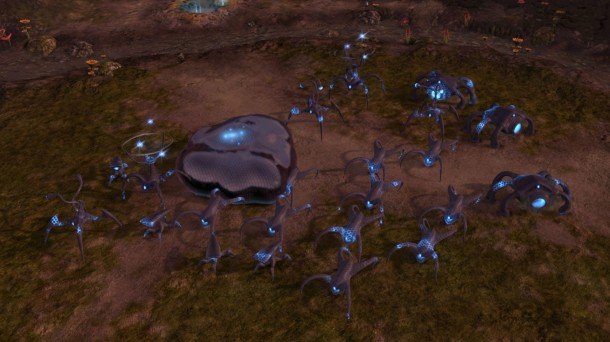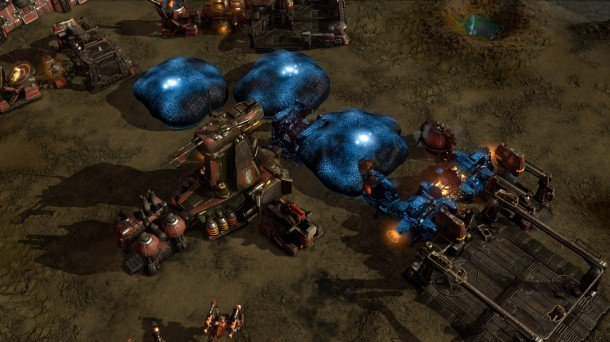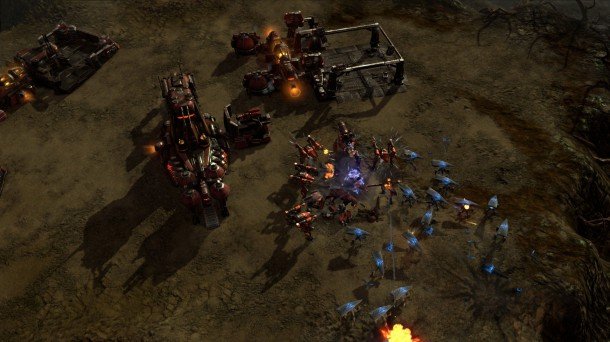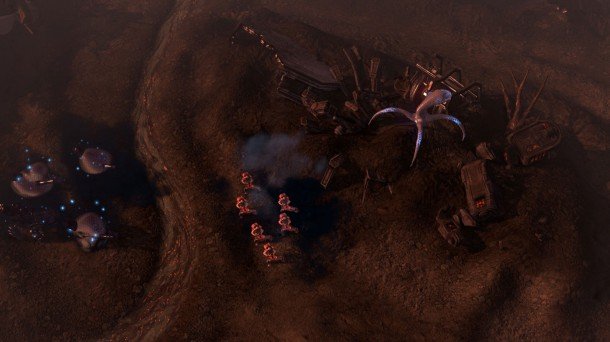
Written by Scott Butterworth
I spent a lot of time playing StarCraft in high school. There have been other real-time strategy games in my life, sure, but StarCraft was my first true love. Consequently, it shaped my expectations for the entire genre. It's also why I'm so fascinated with Grey Goo , the oddly named, sci-fi themed RTS that plays by all the old school rules. As we outlined in our exclusive reveal in March, Grey Goo abides by all the archetypal resource mining, base building, and unit management that defined the classics of the genre.
What separates Grey Goo from the games it seeks to honor are its drastically asymmetrical races, most notably the eponymous, ultra-aggressive Goo. Remember all that stuff I was saying about respecting tradition? The Goo take those expectations and deliberately subvert them.
For starters, they don't have bases. Instead, they have “mother Goos,” massive amorphous blobs that roam around the map absorbing resources and spitting out units like some nomadic primordial ooze. Whatever units you need at any given moment can be spawned almost instantly (assuming you've got the resources), making the Goo an exceptionally unpredictable offensive threat.
Mother goos can also traverse any portion of the environment, an advantage not enjoyed by either of the other races. I watched as my silvery, iridescent blob slithered up a mountain side, where it remained perched out of view (though also out of reach of more resources). Later I discovered mother units can even be split into smaller, semi-autonomous mothers or grown into a massive, tentacled super weapon. At their most powerful, Mother Goos can devour entire bases whole, though I was lead to believe this would take a considerable amount of time and planning to pull off.

The game's two other races have “epic units” as well that will hopefully help counteract these massive mothers, but I didn't see them in action, unfortunately. I did, however, get a small sampling of the Human faction's tactics, which also offer up a few unique mechanical tricks. Their bases, for example, are totally modular and can be rearranged at any time so long as the structures remain connected the base's expandable power grid. If an enemy attacks the north side of your base after you built a ton of turrets on the east side, just pick them up and move them at no cost. Same thing with their defensive walls (yes, walls!).
The order in which you place human structures also impacts the way they function. Building structure A next to structure B will produce a different effect than building A next to C. I didn't actually get to see this particular quirk in action, but it's an intriguing concept nonetheless. I also didn't see the Beta race at all, but according to developer Petroglyph, their bases use a hub-and-spoke structure that offers a greater number of potential configurations than the human's purely defensive-minded building techniques.
Keep up to date with the most important stories and the best deals, as picked by the PC Gamer team.

The actual combat should look totally familiar to any seasoned RTS player: a fog of war shrouds a topographically diverse map littered with resources for mining and bottlenecks for exploiting across which players move massive numbers of tiny units with a few cursor clicks and hotkey punches. My experience with the game at E3 was more of a focused introduction to the Goo faction than a granular exploration of the game as a whole, but according to the Petroglyph rep I spoke with, the team aims to focus the combat more on big picture tactical decisions than unit micromanagement.
Regardless of how the deeper nuances of Grey Goo's combat shape up, just seeing the level of creativity imbued in the Goo has me intrigued. In order to successfully break the rules, you first must learn and understand them; Petroglyph's deep appreciation for the genre is obvious in the Goo. I can only hope the other two races prove equalling compelling once we dive into the finished product this fall.

PC Gamer is the global authority on PC games—starting in 1993 with the magazine, and then in 2010 with this website you're currently reading. We have writers across the US, Canada, UK and Australia, who you can read about here.


